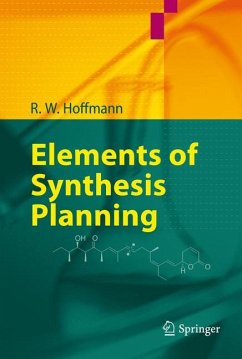Synthesis is at the core of organic chemistry. In order for compounds to be studied-be it as drugs, materials, or because of their physical properties- they have to be prepared, often in multistep synthetic sequences. Thus, the target compound is at the outset of synthesis planning. Synthesis involves creating the target compound from smaller, readily available building blocks. Immediately, questions arise: From which bui- ing blocks? In which sequence? By which reactions? Nature creates many highly complex "natural products" via reaction cascades, in which an asso- ment of starting compounds present within the cell is transformed by speci c (for each target structure) combinations of modular enzymes in speci c - quences into the target compounds [1, 2]. To mimic this ef ciency is the dream of an ideal synthesis [2]. However, we are at present so far from - alising such a "one-pot" operation that actual synthesis has to be achieved via a sequence of individual discrete steps. Thus, we are left with the task of planning each synthesis individually in an optimal fashion. Synthesis planning must be conducted with regard for certain speci - tions, some of which are due to the structure of the target molecule, and some of which relate to external parameters such as costs, environmental compatibility, or novelty. We will not consider these external aspects in this context. Planning of a synthesis is based on a pool of information regarding chemical reactions that can be executed reliably and in high chemical yield.
Dieser Download kann aus rechtlichen Gründen nur mit Rechnungsadresse in A, B, BG, CY, CZ, D, DK, EW, E, FIN, F, GR, HR, H, IRL, I, LT, L, LR, M, NL, PL, P, R, S, SLO, SK ausgeliefert werden.
From the reviews:
"The text is recommended for those with a strong foundation in organic chemistry. ... The book would be quite helpful for those who plan syntheses on a regular basis ... . The text is a useful addition to the library of any synthetic organic chemist or to select undergraduate and graduate curricula. ... Readers will certainly learn more about the chemistry, the logic, and the art of planning a novel synthesis and contributing to a vast and interesting field." (Bridget G. Trogden, Journal of Chemical Education, Vol. 88, 2011)
From an undergraduate learning perspective the concept of synthesis planning or retrosynthesis can appear to be a daunting prospect. The idea of being asked to think backwards for many is a big leap, despite the vast majority already possessing a well-stocked chemical toolbox and being more than capable to explain a multitude of complex mechanistic transformations. In Elements of synthesis planning, a reworked translation of his original German text, Reinhard Hoffmann sets out to 'demystify' the art of synthetic planning, which is an essential and vital skill practised every day throughout the worldwide organic chemistry community.
In 12 clear and logical chapters, Hoffmann takes the reader from the basic concepts of retrosynthesis (use of synthons, identifying key bond disconnections, unmasking symmetry elements etc) to dedicated chapters on the application of chiral building blocks, strategic planning of complex synthetic sequences and the synthesis of polycyclic ring systems. In the final chapter, all these concepts are brought together to elegantly compare several individual approaches to one of five representative natural products, highlighting the tactics and strategies employed.
As such, this text would ideally complement an advanced undergraduate course on complex organic synthesis, which is beyond the level of most standard organic chemistrytextbooks. It would also prove highly useful to postgraduates at the beginning of their research careers in synthesis to inspire creativity and maybe put their ideas into practice.
Gordon Florence , Chemistry World, 2009, 6(8), p. 63
"The text is recommended for those with a strong foundation in organic chemistry. ... The book would be quite helpful for those who plan syntheses on a regular basis ... . The text is a useful addition to the library of any synthetic organic chemist or to select undergraduate and graduate curricula. ... Readers will certainly learn more about the chemistry, the logic, and the art of planning a novel synthesis and contributing to a vast and interesting field." (Bridget G. Trogden, Journal of Chemical Education, Vol. 88, 2011)
From an undergraduate learning perspective the concept of synthesis planning or retrosynthesis can appear to be a daunting prospect. The idea of being asked to think backwards for many is a big leap, despite the vast majority already possessing a well-stocked chemical toolbox and being more than capable to explain a multitude of complex mechanistic transformations. In Elements of synthesis planning, a reworked translation of his original German text, Reinhard Hoffmann sets out to 'demystify' the art of synthetic planning, which is an essential and vital skill practised every day throughout the worldwide organic chemistry community.
In 12 clear and logical chapters, Hoffmann takes the reader from the basic concepts of retrosynthesis (use of synthons, identifying key bond disconnections, unmasking symmetry elements etc) to dedicated chapters on the application of chiral building blocks, strategic planning of complex synthetic sequences and the synthesis of polycyclic ring systems. In the final chapter, all these concepts are brought together to elegantly compare several individual approaches to one of five representative natural products, highlighting the tactics and strategies employed.
As such, this text would ideally complement an advanced undergraduate course on complex organic synthesis, which is beyond the level of most standard organic chemistrytextbooks. It would also prove highly useful to postgraduates at the beginning of their research careers in synthesis to inspire creativity and maybe put their ideas into practice.
Gordon Florence , Chemistry World, 2009, 6(8), p. 63









